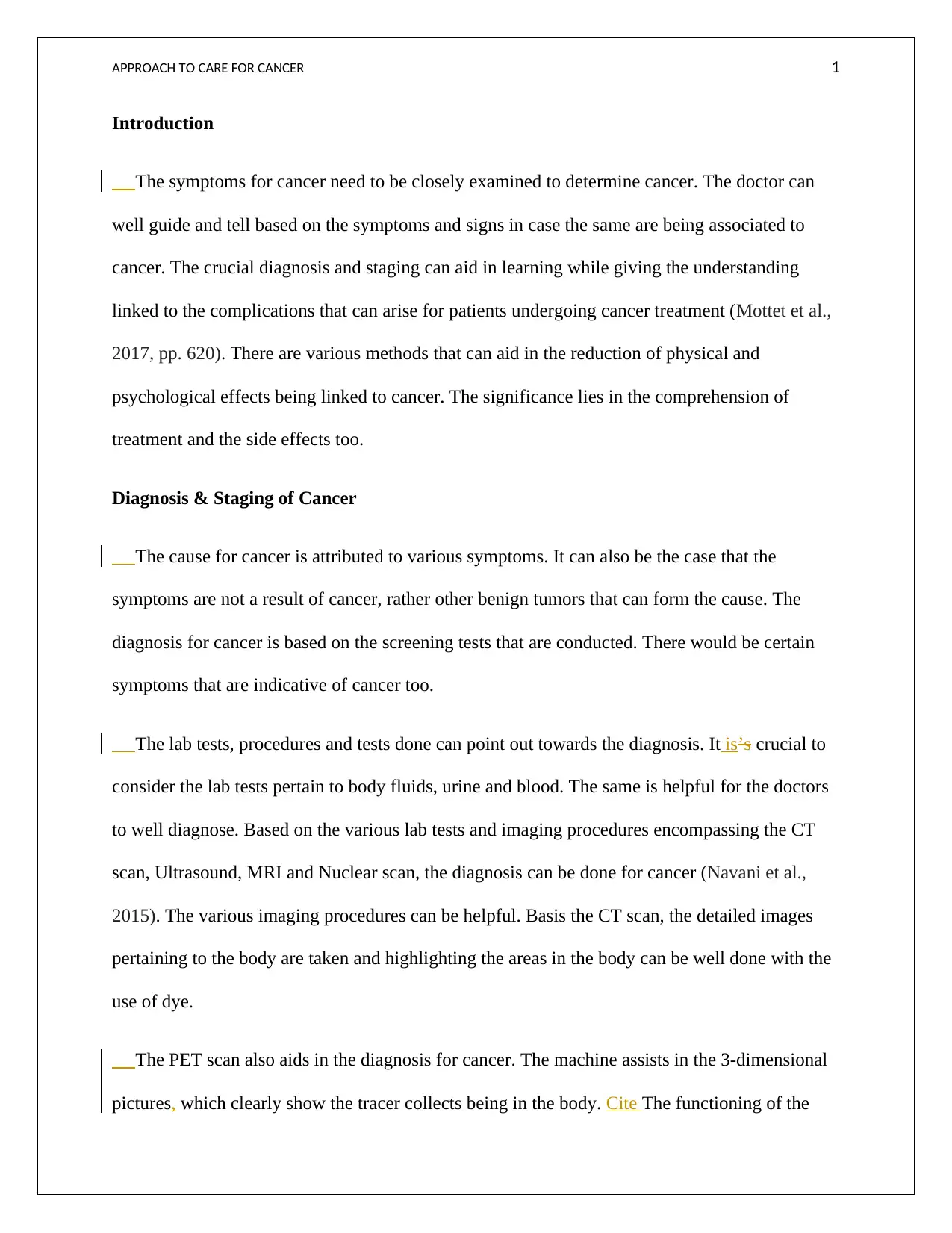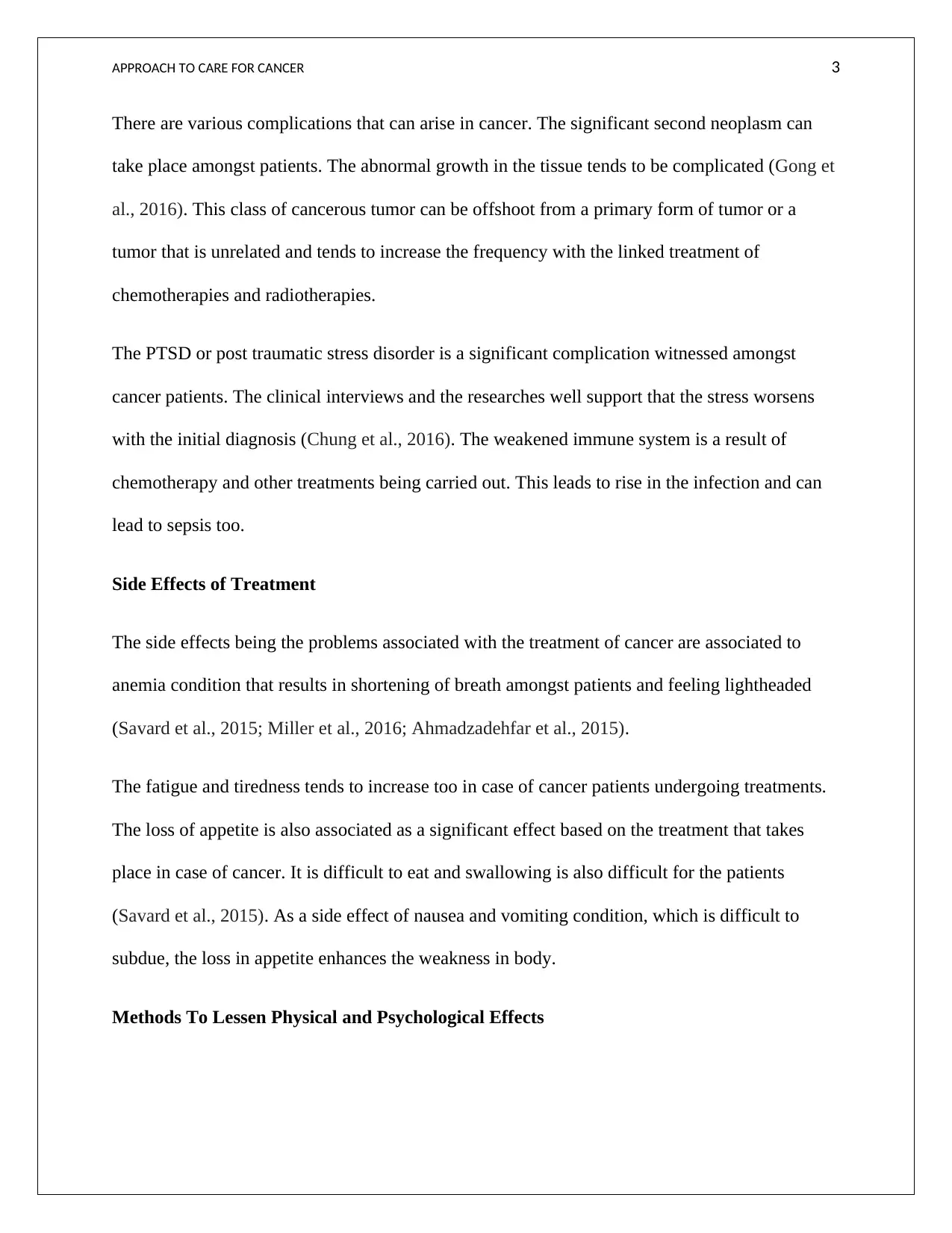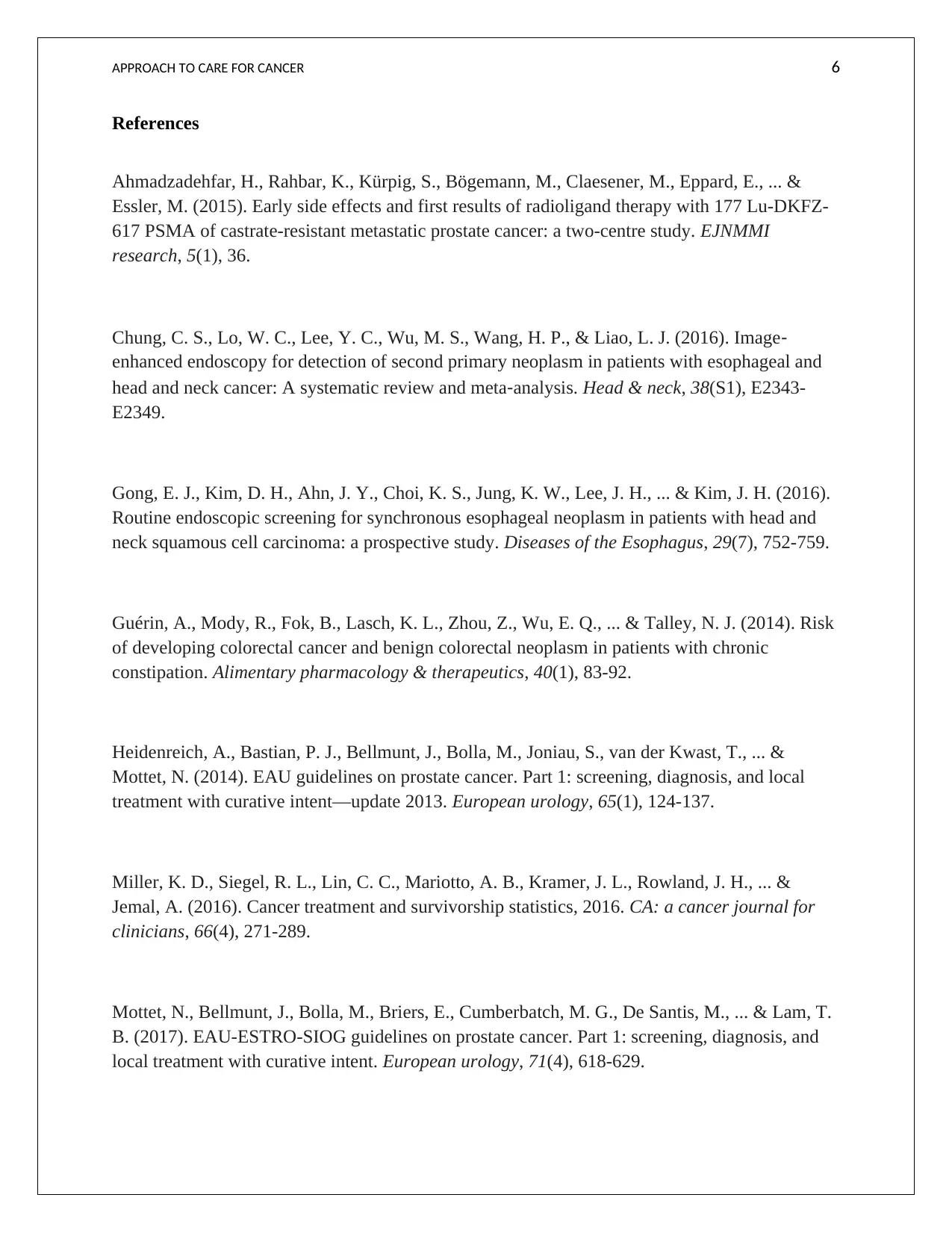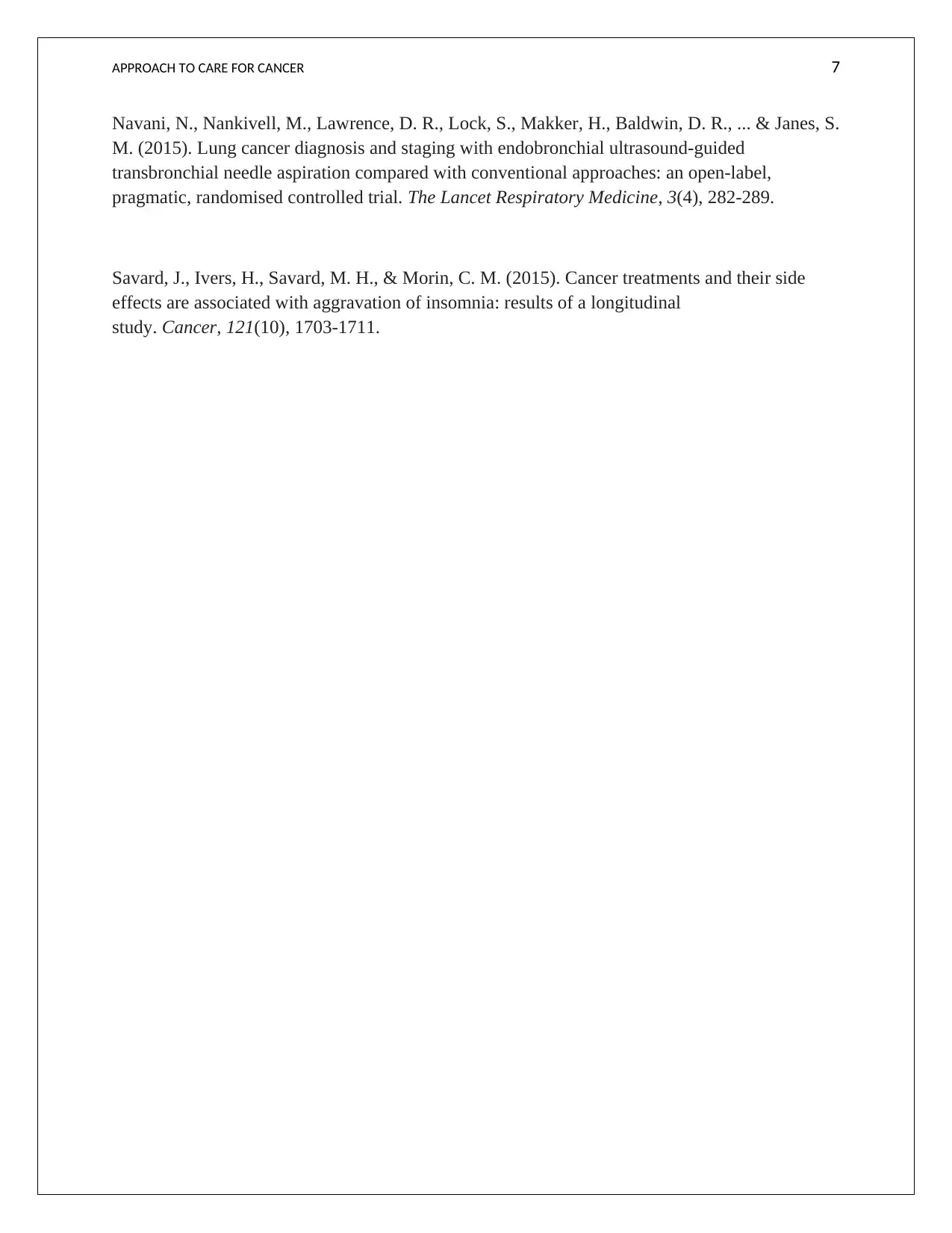Approach to Cancer Care: Diagnosis, Staging, and Complications
VerifiedAdded on 2019/10/09
|8
|1966
|233
Report
AI Summary
This report offers an in-depth analysis of the approach to cancer care, beginning with the diagnostic process, which relies on screening tests, lab analyses of bodily fluids, and imaging procedures like CT scans and PET scans. The report then explores cancer staging using the TNM system to determine the extent of the disease. It identifies potential complications such as secondary neoplasms and psychological distress, particularly PTSD. The report also discusses the side effects associated with cancer treatments, including anemia, fatigue, loss of appetite, nausea, and vomiting. Finally, it highlights various methods to mitigate both the physical and psychological effects of cancer, emphasizing the crucial role of healthcare practitioners, nurses, and family caregivers in providing comprehensive support. The report stresses the importance of understanding the treatments and their side effects to improve patient outcomes.

Running hHead: APPROACH TO CARE FOR CANCER
Approach To Care For Cancer – Tenzin Bhakto, RN
Approach To Care For Cancer – Tenzin Bhakto, RN
Paraphrase This Document
Need a fresh take? Get an instant paraphrase of this document with our AI Paraphraser

APPROACH TO CARE FOR CANCER 1
Introduction
The symptoms for cancer need to be closely examined to determine cancer. The doctor can
well guide and tell based on the symptoms and signs in case the same are being associated to
cancer. The crucial diagnosis and staging can aid in learning while giving the understanding
linked to the complications that can arise for patients undergoing cancer treatment (Mottet et al.,
2017, pp. 620). There are various methods that can aid in the reduction of physical and
psychological effects being linked to cancer. The significance lies in the comprehension of
treatment and the side effects too.
Diagnosis & Staging of Cancer
The cause for cancer is attributed to various symptoms. It can also be the case that the
symptoms are not a result of cancer, rather other benign tumors that can form the cause. The
diagnosis for cancer is based on the screening tests that are conducted. There would be certain
symptoms that are indicative of cancer too.
The lab tests, procedures and tests done can point out towards the diagnosis. It is’s crucial to
consider the lab tests pertain to body fluids, urine and blood. The same is helpful for the doctors
to well diagnose. Based on the various lab tests and imaging procedures encompassing the CT
scan, Ultrasound, MRI and Nuclear scan, the diagnosis can be done for cancer (Navani et al.,
2015). The various imaging procedures can be helpful. Basis the CT scan, the detailed images
pertaining to the body are taken and highlighting the areas in the body can be well done with the
use of dye.
The PET scan also aids in the diagnosis for cancer. The machine assists in the 3-dimensional
pictures, which clearly show the tracer collects being in the body. Cite The functioning of the
Introduction
The symptoms for cancer need to be closely examined to determine cancer. The doctor can
well guide and tell based on the symptoms and signs in case the same are being associated to
cancer. The crucial diagnosis and staging can aid in learning while giving the understanding
linked to the complications that can arise for patients undergoing cancer treatment (Mottet et al.,
2017, pp. 620). There are various methods that can aid in the reduction of physical and
psychological effects being linked to cancer. The significance lies in the comprehension of
treatment and the side effects too.
Diagnosis & Staging of Cancer
The cause for cancer is attributed to various symptoms. It can also be the case that the
symptoms are not a result of cancer, rather other benign tumors that can form the cause. The
diagnosis for cancer is based on the screening tests that are conducted. There would be certain
symptoms that are indicative of cancer too.
The lab tests, procedures and tests done can point out towards the diagnosis. It is’s crucial to
consider the lab tests pertain to body fluids, urine and blood. The same is helpful for the doctors
to well diagnose. Based on the various lab tests and imaging procedures encompassing the CT
scan, Ultrasound, MRI and Nuclear scan, the diagnosis can be done for cancer (Navani et al.,
2015). The various imaging procedures can be helpful. Basis the CT scan, the detailed images
pertaining to the body are taken and highlighting the areas in the body can be well done with the
use of dye.
The PET scan also aids in the diagnosis for cancer. The machine assists in the 3-dimensional
pictures, which clearly show the tracer collects being in the body. Cite The functioning of the

APPROACH TO CARE FOR CANCER 2
organs and tissues and the manner they are functioning can be well determined with the PET
scan (Heidenreich et al., 2014). The biopsy is helpful in diagnosis too. The procedure involves
the removal of sample of tissue.
A pathologist is able to determine the presence of cancerous cells in the tissue through a
microscopic view of the same. The biopsy can be performed through the needle or with the help
of surgery or endoscopy being conducted.
Staging is a manner in which the size of cancer or to the extent it has spread can be well
determined. In the diagnosis with the screening procedures or through the aids of biopsy
conducted, doctors are able to determine the spread (Navani et al., 2015). The system of TNM
tends to be effective in the analysis.
While the abbreviation denotes Tumour, Node and Metastasis, the staging number from 1-4 are
indicative in cancer. Cite The stage one signifies the extent to a smaller region and relatively
smaller size. Cite The stage two is bigger in size and extent as compared to stage one (Mottet et
al., 2017, pp. 620). The stage two also remarks that the cancer cells have been spread into the
various lymph nodes, which are closer to tumor. Cite
A larger size is denoted from the stage three and this is when the spread takes place in the
adjoining tissue (Navani et al., 2015). The last stage or stage four does indicate that another body
organ has been impacted due to cancer and the stage is also remarked as metastatic cancer or
being secondary in nature. Cite
Complication in Cancer
organs and tissues and the manner they are functioning can be well determined with the PET
scan (Heidenreich et al., 2014). The biopsy is helpful in diagnosis too. The procedure involves
the removal of sample of tissue.
A pathologist is able to determine the presence of cancerous cells in the tissue through a
microscopic view of the same. The biopsy can be performed through the needle or with the help
of surgery or endoscopy being conducted.
Staging is a manner in which the size of cancer or to the extent it has spread can be well
determined. In the diagnosis with the screening procedures or through the aids of biopsy
conducted, doctors are able to determine the spread (Navani et al., 2015). The system of TNM
tends to be effective in the analysis.
While the abbreviation denotes Tumour, Node and Metastasis, the staging number from 1-4 are
indicative in cancer. Cite The stage one signifies the extent to a smaller region and relatively
smaller size. Cite The stage two is bigger in size and extent as compared to stage one (Mottet et
al., 2017, pp. 620). The stage two also remarks that the cancer cells have been spread into the
various lymph nodes, which are closer to tumor. Cite
A larger size is denoted from the stage three and this is when the spread takes place in the
adjoining tissue (Navani et al., 2015). The last stage or stage four does indicate that another body
organ has been impacted due to cancer and the stage is also remarked as metastatic cancer or
being secondary in nature. Cite
Complication in Cancer
⊘ This is a preview!⊘
Do you want full access?
Subscribe today to unlock all pages.

Trusted by 1+ million students worldwide

APPROACH TO CARE FOR CANCER 3
There are various complications that can arise in cancer. The significant second neoplasm can
take place amongst patients. The abnormal growth in the tissue tends to be complicated (Gong et
al., 2016). This class of cancerous tumor can be offshoot from a primary form of tumor or a
tumor that is unrelated and tends to increase the frequency with the linked treatment of
chemotherapies and radiotherapies.
The PTSD or post traumatic stress disorder is a significant complication witnessed amongst
cancer patients. The clinical interviews and the researches well support that the stress worsens
with the initial diagnosis (Chung et al., 2016). The weakened immune system is a result of
chemotherapy and other treatments being carried out. This leads to rise in the infection and can
lead to sepsis too.
Side Effects of Treatment
The side effects being the problems associated with the treatment of cancer are associated to
anemia condition that results in shortening of breath amongst patients and feeling lightheaded
(Savard et al., 2015; Miller et al., 2016; Ahmadzadehfar et al., 2015).
The fatigue and tiredness tends to increase too in case of cancer patients undergoing treatments.
The loss of appetite is also associated as a significant effect based on the treatment that takes
place in case of cancer. It is difficult to eat and swallowing is also difficult for the patients
(Savard et al., 2015). As a side effect of nausea and vomiting condition, which is difficult to
subdue, the loss in appetite enhances the weakness in body.
Methods To Lessen Physical and Psychological Effects
There are various complications that can arise in cancer. The significant second neoplasm can
take place amongst patients. The abnormal growth in the tissue tends to be complicated (Gong et
al., 2016). This class of cancerous tumor can be offshoot from a primary form of tumor or a
tumor that is unrelated and tends to increase the frequency with the linked treatment of
chemotherapies and radiotherapies.
The PTSD or post traumatic stress disorder is a significant complication witnessed amongst
cancer patients. The clinical interviews and the researches well support that the stress worsens
with the initial diagnosis (Chung et al., 2016). The weakened immune system is a result of
chemotherapy and other treatments being carried out. This leads to rise in the infection and can
lead to sepsis too.
Side Effects of Treatment
The side effects being the problems associated with the treatment of cancer are associated to
anemia condition that results in shortening of breath amongst patients and feeling lightheaded
(Savard et al., 2015; Miller et al., 2016; Ahmadzadehfar et al., 2015).
The fatigue and tiredness tends to increase too in case of cancer patients undergoing treatments.
The loss of appetite is also associated as a significant effect based on the treatment that takes
place in case of cancer. It is difficult to eat and swallowing is also difficult for the patients
(Savard et al., 2015). As a side effect of nausea and vomiting condition, which is difficult to
subdue, the loss in appetite enhances the weakness in body.
Methods To Lessen Physical and Psychological Effects
Paraphrase This Document
Need a fresh take? Get an instant paraphrase of this document with our AI Paraphraser

APPROACH TO CARE FOR CANCER 4
It is crucial that the physical effects based on the cancer treatments are being reduced amongst
the patients suffering from cancer (Savard et al., 2015; Miller et al., 2016; Ahmadzadehfar et al.,
2015). It is essential that the side effects in case of cancer case to case is being well determined
by the practitioner and nurses to aid in reducing the effect (Navani et al., 2015). The primary
family caregivers play a significant role too in reducing the physical and psychological effects.
With the consideration of alternative medicine too, the psychological effects can be considerably
reduced.
Conclusion
There are significant methods, which can aid in the reduction of physical and psychological
effects being associated to cancer. The diagnosis for cancer lies on the screening tests, which are
being conducted. With respect to the symptoms that are indicative of cancer, the lab tests along
with procedures and tests done can indicate towards the diagnosis. It is’s important to consider
the lab tests related to body fluids, urine and blood. Staging is considered to be an effective way
in which the size of cancer and to the extent it has spread can be known. With the screening
procedures and the biopsy conducted, doctors can determine the spread. The abnormal growth in
the tissue can create complications. This class of cancerous tumor is the offshoot from a primary
form of tumor. It can also be the tumor that is unrelated. This does tend to enhance the frequency
with the linked treatment of chemotherapies and radiotherapies. The role of primary family
caregivers aids in reducing the physical and psychological effects.
Tenzin,
It is crucial that the physical effects based on the cancer treatments are being reduced amongst
the patients suffering from cancer (Savard et al., 2015; Miller et al., 2016; Ahmadzadehfar et al.,
2015). It is essential that the side effects in case of cancer case to case is being well determined
by the practitioner and nurses to aid in reducing the effect (Navani et al., 2015). The primary
family caregivers play a significant role too in reducing the physical and psychological effects.
With the consideration of alternative medicine too, the psychological effects can be considerably
reduced.
Conclusion
There are significant methods, which can aid in the reduction of physical and psychological
effects being associated to cancer. The diagnosis for cancer lies on the screening tests, which are
being conducted. With respect to the symptoms that are indicative of cancer, the lab tests along
with procedures and tests done can indicate towards the diagnosis. It is’s important to consider
the lab tests related to body fluids, urine and blood. Staging is considered to be an effective way
in which the size of cancer and to the extent it has spread can be known. With the screening
procedures and the biopsy conducted, doctors can determine the spread. The abnormal growth in
the tissue can create complications. This class of cancerous tumor is the offshoot from a primary
form of tumor. It can also be the tumor that is unrelated. This does tend to enhance the frequency
with the linked treatment of chemotherapies and radiotherapies. The role of primary family
caregivers aids in reducing the physical and psychological effects.
Tenzin,

APPROACH TO CARE FOR CANCER 5
You gave an explanation of the diagnosis and staging of cancer. I don’t see three complications of cancer
with available treatments or recommendations to address physiological and psychological side effects of
care. You don’t have a thesis statement. Please refer to the Writing Center or Purdue OWL for additional
help with APA formatting. The border is not APA. There are many grammatical errors. Let me know if
you have questions.
Sheral
I got only 60% for this paper, my expectation was way higher than this since it was redo paper
and thought this writer is an expert. Many silly mistakes were made and the person did very poor
work. I am surprised and upset.
You gave an explanation of the diagnosis and staging of cancer. I don’t see three complications of cancer
with available treatments or recommendations to address physiological and psychological side effects of
care. You don’t have a thesis statement. Please refer to the Writing Center or Purdue OWL for additional
help with APA formatting. The border is not APA. There are many grammatical errors. Let me know if
you have questions.
Sheral
I got only 60% for this paper, my expectation was way higher than this since it was redo paper
and thought this writer is an expert. Many silly mistakes were made and the person did very poor
work. I am surprised and upset.
⊘ This is a preview!⊘
Do you want full access?
Subscribe today to unlock all pages.

Trusted by 1+ million students worldwide

APPROACH TO CARE FOR CANCER 6
References
Ahmadzadehfar, H., Rahbar, K., Kürpig, S., Bögemann, M., Claesener, M., Eppard, E., ... &
Essler, M. (2015). Early side effects and first results of radioligand therapy with 177 Lu-DKFZ-
617 PSMA of castrate-resistant metastatic prostate cancer: a two-centre study. EJNMMI
research, 5(1), 36.
Chung, C. S., Lo, W. C., Lee, Y. C., Wu, M. S., Wang, H. P., & Liao, L. J. (2016). Image‐
enhanced endoscopy for detection of second primary neoplasm in patients with esophageal and
head and neck cancer: A systematic review and meta‐analysis. Head & neck, 38(S1), E2343-
E2349.
Gong, E. J., Kim, D. H., Ahn, J. Y., Choi, K. S., Jung, K. W., Lee, J. H., ... & Kim, J. H. (2016).
Routine endoscopic screening for synchronous esophageal neoplasm in patients with head and
neck squamous cell carcinoma: a prospective study. Diseases of the Esophagus, 29(7), 752-759.
Guérin, A., Mody, R., Fok, B., Lasch, K. L., Zhou, Z., Wu, E. Q., ... & Talley, N. J. (2014). Risk
of developing colorectal cancer and benign colorectal neoplasm in patients with chronic
constipation. Alimentary pharmacology & therapeutics, 40(1), 83-92.
Heidenreich, A., Bastian, P. J., Bellmunt, J., Bolla, M., Joniau, S., van der Kwast, T., ... &
Mottet, N. (2014). EAU guidelines on prostate cancer. Part 1: screening, diagnosis, and local
treatment with curative intent—update 2013. European urology, 65(1), 124-137.
Miller, K. D., Siegel, R. L., Lin, C. C., Mariotto, A. B., Kramer, J. L., Rowland, J. H., ... &
Jemal, A. (2016). Cancer treatment and survivorship statistics, 2016. CA: a cancer journal for
clinicians, 66(4), 271-289.
Mottet, N., Bellmunt, J., Bolla, M., Briers, E., Cumberbatch, M. G., De Santis, M., ... & Lam, T.
B. (2017). EAU-ESTRO-SIOG guidelines on prostate cancer. Part 1: screening, diagnosis, and
local treatment with curative intent. European urology, 71(4), 618-629.
References
Ahmadzadehfar, H., Rahbar, K., Kürpig, S., Bögemann, M., Claesener, M., Eppard, E., ... &
Essler, M. (2015). Early side effects and first results of radioligand therapy with 177 Lu-DKFZ-
617 PSMA of castrate-resistant metastatic prostate cancer: a two-centre study. EJNMMI
research, 5(1), 36.
Chung, C. S., Lo, W. C., Lee, Y. C., Wu, M. S., Wang, H. P., & Liao, L. J. (2016). Image‐
enhanced endoscopy for detection of second primary neoplasm in patients with esophageal and
head and neck cancer: A systematic review and meta‐analysis. Head & neck, 38(S1), E2343-
E2349.
Gong, E. J., Kim, D. H., Ahn, J. Y., Choi, K. S., Jung, K. W., Lee, J. H., ... & Kim, J. H. (2016).
Routine endoscopic screening for synchronous esophageal neoplasm in patients with head and
neck squamous cell carcinoma: a prospective study. Diseases of the Esophagus, 29(7), 752-759.
Guérin, A., Mody, R., Fok, B., Lasch, K. L., Zhou, Z., Wu, E. Q., ... & Talley, N. J. (2014). Risk
of developing colorectal cancer and benign colorectal neoplasm in patients with chronic
constipation. Alimentary pharmacology & therapeutics, 40(1), 83-92.
Heidenreich, A., Bastian, P. J., Bellmunt, J., Bolla, M., Joniau, S., van der Kwast, T., ... &
Mottet, N. (2014). EAU guidelines on prostate cancer. Part 1: screening, diagnosis, and local
treatment with curative intent—update 2013. European urology, 65(1), 124-137.
Miller, K. D., Siegel, R. L., Lin, C. C., Mariotto, A. B., Kramer, J. L., Rowland, J. H., ... &
Jemal, A. (2016). Cancer treatment and survivorship statistics, 2016. CA: a cancer journal for
clinicians, 66(4), 271-289.
Mottet, N., Bellmunt, J., Bolla, M., Briers, E., Cumberbatch, M. G., De Santis, M., ... & Lam, T.
B. (2017). EAU-ESTRO-SIOG guidelines on prostate cancer. Part 1: screening, diagnosis, and
local treatment with curative intent. European urology, 71(4), 618-629.
Paraphrase This Document
Need a fresh take? Get an instant paraphrase of this document with our AI Paraphraser

APPROACH TO CARE FOR CANCER 7
Navani, N., Nankivell, M., Lawrence, D. R., Lock, S., Makker, H., Baldwin, D. R., ... & Janes, S.
M. (2015). Lung cancer diagnosis and staging with endobronchial ultrasound-guided
transbronchial needle aspiration compared with conventional approaches: an open-label,
pragmatic, randomised controlled trial. The Lancet Respiratory Medicine, 3(4), 282-289.
Savard, J., Ivers, H., Savard, M. H., & Morin, C. M. (2015). Cancer treatments and their side
effects are associated with aggravation of insomnia: results of a longitudinal
study. Cancer, 121(10), 1703-1711.
Navani, N., Nankivell, M., Lawrence, D. R., Lock, S., Makker, H., Baldwin, D. R., ... & Janes, S.
M. (2015). Lung cancer diagnosis and staging with endobronchial ultrasound-guided
transbronchial needle aspiration compared with conventional approaches: an open-label,
pragmatic, randomised controlled trial. The Lancet Respiratory Medicine, 3(4), 282-289.
Savard, J., Ivers, H., Savard, M. H., & Morin, C. M. (2015). Cancer treatments and their side
effects are associated with aggravation of insomnia: results of a longitudinal
study. Cancer, 121(10), 1703-1711.
1 out of 8
Related Documents
Your All-in-One AI-Powered Toolkit for Academic Success.
+13062052269
info@desklib.com
Available 24*7 on WhatsApp / Email
![[object Object]](/_next/static/media/star-bottom.7253800d.svg)
Unlock your academic potential
Copyright © 2020–2025 A2Z Services. All Rights Reserved. Developed and managed by ZUCOL.





